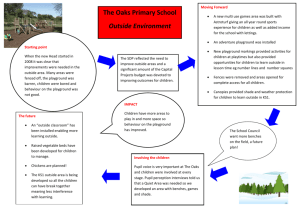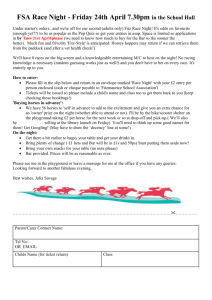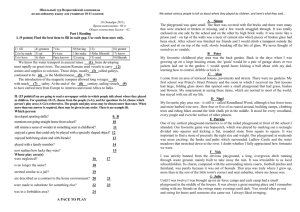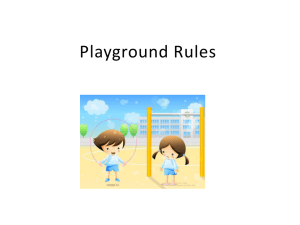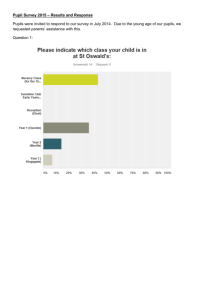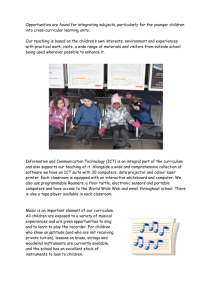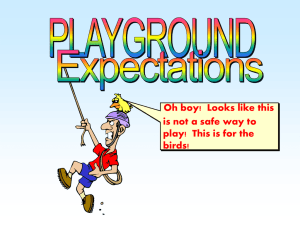A LONGITUDINAL STUDY OF PLAYGROUND SURFACES TO
advertisement
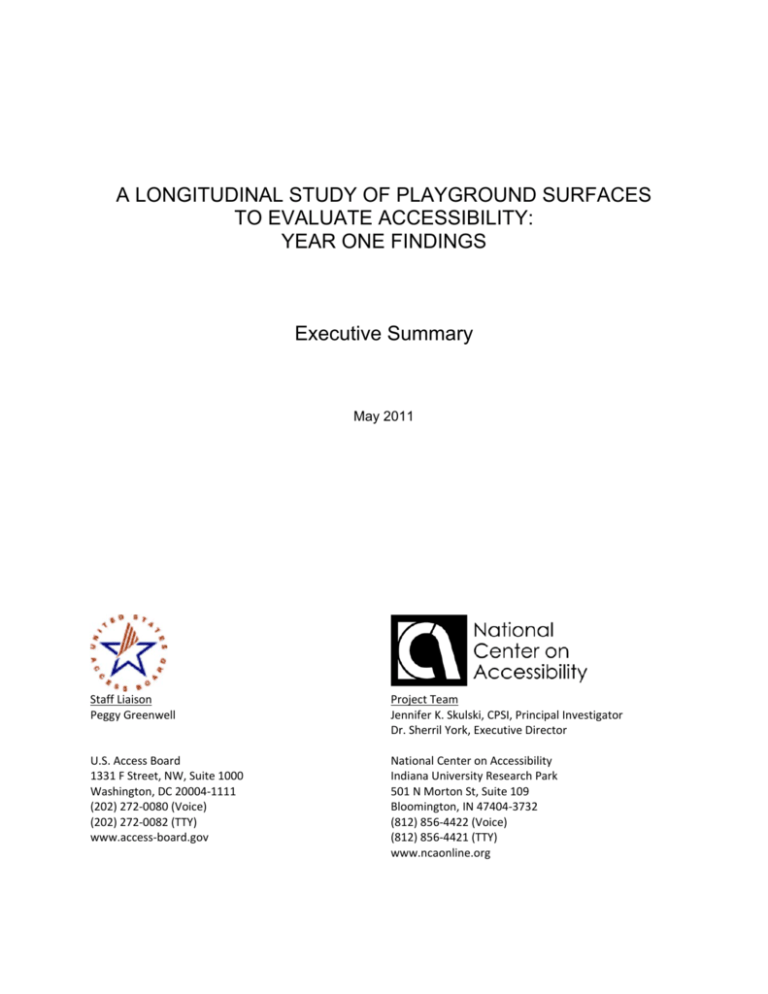
A LONGITUDINAL STUDY OF PLAYGROUND SURFACES TO EVALUATE ACCESSIBILITY: YEAR ONE FINDINGS Executive Summary May 2011 Staff Liaison Peggy Greenwell U.S. Access Board 1331 F Street, NW, Suite 1000 Washington, DC 20004‐1111 (202) 272‐0080 (Voice) (202) 272‐0082 (TTY) www.access‐board.gov Project Team Jennifer K. Skulski, CPSI, Principal Investigator Dr. Sherril York, Executive Director National Center on Accessibility Indiana University Research Park 501 N Morton St, Suite 109 Bloomington, IN 47404‐3732 (812) 856‐4422 (Voice) (812) 856‐4421 (TTY) www.ncaonline.org NCA Playground Surface Study: Year One Findings A Longitudinal Study of Playground Surfaces to Evaluate Accessibility: Year One Findings Executive Summary Purpose In 2008, the National Center on Accessibility (NCA) at Indiana University initiated a longitudinal study of playground surfaces with research funding by the U.S. Access Board. The purpose of this longitudinal study is to evaluate a variety of playground surfaces, their ability to meet accessibility requirements, their costs upon initial installation and maintenance over 3-5years. The following information is a summary of year one findings. Data collection for the longitudinal study is scheduled to continue through September 2012, with a comprehensive report of findings to follow. Background When the playground presents physical barriers such as inaccessible surfaces and routes, play, learning, development and the self-actualized benefits of the leisure experience can be stunted or even eliminated for a child with a disability. Inaccessible surfaces can prevent children with physical disabilities who may use canes, crutches, walkers or wheelchairs from ambulating through the play area. The 2010 Americans with Disabilities Act (ADA) Standards for Accessible Design and the Architectural Barriers Act (ABA) Accessibility Standards require newly constructed playgrounds and those existing playgrounds that are altered to comply with a series of technical provisions for accessible play components and the accessible route to those components. Criteria specify a maximum running slope for a ground level accessible route (1:16 or 6.25%), maximum cross slope (1:48 or 2.08%), minimum clear width (60 inches), limit on a change of level along the route or on the clear spaces (no more than .50 inch), and vertical clearance up to 80 inches. In addition, the ground surface must meet the ASTM F1951-99 Standard Specification for Determination of Accessibility of Surface Systems Under and Around Playground Equipment. The technical provisions further state that ground surfaces shall be inspected and maintained regularly and frequently to ensure continued compliance with ASTM F1951-99. Ground surfaces that are part of the accessible use and also located in the use zones must meet ASTM F1292 Standard Specification for Impact Attenuation of Surface Systems Under and Around Playground Equipment. According to the Final Accessibility Guidelines for Play Areas Economic Assessment, the Americans with Disabilities Act Accessibility Guidelines are estimated to affect as many as 5,300 new playgrounds and 18,600 renovated playgrounds annually. Between 5,650 and 8,770 playgrounds at public schools and municipal parks are estimated to be replaced; and 380 to 520 new playgrounds are constructed at public schools and municipal parks each year. Thus, choosing play surfaces that are accessible upon installation and can be maintained as accessible becomes one of the most critical decisions during the playground planning and design phases. Results of an online buyers’ guide search identifies more than 100 different commercial varieties of playground surfaces on the market. Many claim to meet the national standards for safety and accessibility. The range of product claims, advantages and disadvantages, the differential in costs for installation and maintenance, and claimed life cycle lead playground owners on a guessing game as to which product is most cost effective and reliable over time. Lack of reliable product performance data on the effectiveness of safe, accessible playground surfaces relative to costs for installation and ongoing maintenance prevents public playground owners National Center on Accessibility 1 NCA Playground Surface Study: Year One Findings from making informed choices on the selection of surfaces most appropriate for their public setting. Research Design The research design for this study has been in development since 2005 with input from a national advisory committee. It is purposeful to derive quantitative and qualitative data through the 3-5 year study. The advisory committee members provided feedback on the categories of surfaces to be evaluated, the criteria to be used for evaluation, the locations within each playground to be evaluated, data collection worksheets and on-site protocol. Newly constructed public playgrounds were selected for participation as test sites in the study. A purposive snowball sampling technique was used to recruit local park and recreation agencies by phone, e-mail and in person. Selection was based upon: accessibility to children with and without disabilities; use of surface materials and products consistent with the study; geographic location; seasonal weather conditions; and willingness of owner/operator to participate as a partner in the study by sharing information and collecting data. The study is limited to the geographic area surrounding the Indiana University-Bloomington campus, Indianapolis and Chicago, within driving distance of the Bloomington-based research team and easily accessed at any given time during the season. The geographic area also supports a close network of practitioners in the field whereby test sites can continue to be recruited. Five categories of playground surfaces have been identified for evaluation in the longitudinal study: 1. 2. 3. 4. 5. Engineered wood fiber product; Shredded rubber/crumb rubber; Unitary rubber mat surfaces; Unitary rubber “poured in place” surfaces; Combination or hybrid surface systems under development. The playground surface products considered for this study had to initially meet the requirements of: ADA-ABA 1008.2 Accessible Routes; ADA-ABA 1008.2.6 Ground Surfaces; ASTM F1292-99 Standard Specification for Impact Attenuation of Surface Systems Under and Around Playground Equipment as determined by the surface manufacturer in laboratory testing; ASTM F1951-99 Standard Specification for Determination of Accessibility of Surface Systems Under and Around Playground Equipment as determined by the surface manufacturer in laboratory testing; and ASTM F2075 Standard Specification for Engineered Wood Fiber for Use as a Playground Safety Surface Under and Around Playground Equipment. Nine critical areas were inspected within 12 months of installation and continue to be evaluated at least once a year for the longitudinal study: 1. 2. 3. 4. 5. 6. 7. 8. 9. Entry to playground where playground surface starts Accessible route connecting accessible play elements Egress point of slide(s) Swings Entry point(s) to composite structure(s)/transfer stations Climber(s) Ground level play element(s) such as spring rockers, play tables, interactive panels, etc Sliding poles Other areas (i.e. water play elements, etc) National Center on Accessibility 2 NCA Playground Surface Study: Year One Findings Four instruments were used for data collection. Upon installation, the playground owner completed a questionnaire on the type, size and intended age group of the playground, the total cost for the equipment, surface materials and installation. An on-site inspection form was created to collect information on the nine locations identifying deficiencies in slope, cross slope, changes in level and openings in the surface. Following the visual inspection of the nine locations, testing for wheelchair accessibility specific to firmness and stability was conducted with the application of a Rotational Penetrometer (RP). Testing for impact attenuation per ASTM F1292 was conducted as an optional test at the discretion of the playground owner using the TRIAX 2000. Approximately 27 sites were recruited for participation during the evaluation period from October 2008 through September 2010. All of the playground sites were located in municipal public parks. Sites included either neighborhood playgrounds or those located in regional parks. Playgrounds at schools, childcare facilities, churches and malls were excluded from participation in the study based on what might be perceived differences of maintenance resources between public park agencies and other entities. Two park agencies gave verbal commitments for participation in the study and then opted out of participation concerned with the possibility of negative budgetary implications should any deficiencies be identified during the site assessment and corrective actions become necessary. Thus, a total of 25 sites were evaluated in this first year summary of findings. The playground sites ranged from 2,400 sq. ft. to 12,000 sq. ft. The costs for surfaces, materials and installation, ranged from $1.08/sq. ft. to $21/sq. ft. Performance and the Surface Deficiency Score Upon arrival at the playground site, a visual inspection was conducted at nine pre-determined locations within the play area. In conjunction with the visual inspection a digital level and tape measure were used to identify instances where four minimum requirements for accessible routes and clear spaces such as the surface running slope exceeded 1:16 (6.25%); the cross slope exceeded 1:48 (2.08%); there was a change in level greater than .50 inch; or an opening greater than .50 inch diameter. If yes, the location was awarded a value of 1 for each characteristic of deficiency with a maximum Surface Deficiency Score (SDS) of 4 for each location. An SDS of 0 shows no interruption of the accessible route or clear floor space at the location. Table 1 Surface Deficiency Score (SDS) within One Year of Installation Surface by Type N Mean Mode Poured in place (PIP) 50 .00 0 Tiles (TIL) 39 .36 0 Engineered Wood Fiber (EWF) 70 2.16 3 Hybrid Surface Systems (HYB) 26 .04 0 (N) = Number of locations visually inspected. Within 12 months of installation, analysis of the SDS among the sample sites indicated there was significant difference in the number of identified deficiencies between EWF and the other three surfaces. Table 1 provides the SDS for each surface type within one year of installation. As might be predicted among public playground owners, within one year of installation PIP scored the lowest SDS with a Mean = 0, while EWF scored the highest with a Mean = 2.16. National Center on Accessibility 3 NCA Playground Surface Study: Year One Findings The greatest number of deficiencies in the playgrounds surfaced with EWF was identified along the accessible route connecting play elements, at climbers and other ground level components. EWF surface locations with greater surface area, such as the accessible route connecting play components had more occurrences of uneven wear, while play components meant for aggress or egress showed more signs where the 30 x 48 inch clear floor space had displaced surface material such as the “kick out” area at the ground level components, the bottom of slides and swings. Performance for Surface Firmness and Stability In addition to the visual inspection and calculation of the surface deficiency score, the firmness and stability of the surfaces were measured at each of the nine locations using the Rotational Penetrometer (RP). Research with the RP shows repeatability and reproducibility consistent to that of the test procedure for ASTM F1951-99. Similar to the F1951-99 lab test, smaller values would indicate less work force necessary to move across the surface, while higher values would indicate greater work force to move across the surface. Prior to taking readings of the playground surfaces, baselines were established on cement or asphalt. The baseline for firmness ranged from .14 to .16 inches and the baseline for stability ranged from .16 to .18 inches. The baseline measurements affirmed the RP was operable and calibrated. Using the RP at each location, five readings were taken and then averaged to result in one measurement for said location. Thus, in a playground identified with all nine locations, a total of 45 readings were collected, five at each location. Table 2 shows the measurement mean for firmness and stability by surface type. Interestingly, all four of the surface types have a mean less than .50 inches for firmness. The second reading, for stability, begins to illustrate the difference among surface types. The mean for stability remains under .50 inches for the three types of unitary surfaces, while the loose fill, EWF, has a mean for stability of .78 inches. Table 2 Firmness and Stability by Surface Type Firmness Stability PIP TIL EWF HYB PIP TIL EWF HYB N 50 39 70 26 50 39 70 26 Mean .36308 .27805 .34206 .43969 .40876 .31687 .78200 .49385 Std. Deviation .060747 .028579 .051741 .060899 .069118 .056598 .130442 .069247 Std. Error .008591 .004576 .006184 .011943 .009775 .009063 .015591 .013580 Min. .228 .216 .258 .336 .264 .246 .518 .372 Max. .480 .342 .568 .566 .598 .596 1.162 .606 (N) = Number of locations visually inspected. The stability measurement, the second measurement in the series using the RP, showed a wide range among the different surface types. The stability measurement had a range of .04 to .06 inches for the unitary surfaces, while the loose fill EWF had a difference of .44 inches. Also of note was that the standard deviation for stability with the EWF was the highest at .13. The high standard deviation for EWF raises questions whether the material characteristic for stability and its high variability can serve as a preliminary indicator that surface types with greater variance National Center on Accessibility 4 NCA Playground Surface Study: Year One Findings will require additional maintenance over time. Interestingly, the two surfaces that are most characteristically different from one another, PIP and EWF, do not have statistically different values for firmness in this study sample. As noted in Table 2, their mean difference for firmness is only.02 inches. Aside from this comparison of firmness for PIP and EWF, all of the rest of the surfaces show a statistically significant difference in mean values for firmness and stability. When the standard deviation of measurements for firmness and stability are compared, the only statistically significant difference is between EWF and the other three surface types in the sample. There was no significant difference in standard deviation for firmness and stability among the three unitary surfaces in the study when compared to one another. This could suggest a statistical difference between unitary and loose fill surface materials when their standard deviation for firmness and stability are compared. It also reiterates the research question for the longitudinal study as to whether surfaces with greater characteristic variability will require more maintenance over time. Over the course of the study, members of the study advisory committee suggested that the sum of the firmness and stability measurements should be considered as a starting point to develop a pass/fail value for the field test with the RP. Table 3 shows the mean score for the measurements of firmness and stability when added together along with the range of high and low measurements. The TIL has the lowest Mean = .60 inches when the average measurements of firmness and stability are added together. As one might predict, EWF has the highest Mean = 1.07 inches for the sum of firmness and stability. It should be noted that the means for both EWF and HYB are quite close in value. Further analysis shows there to be a bivariate correlation between the sum of firmness and stability and the SDS with three of the four types of surfaces. There was no correlation shown with the HYB surface systems. The HYB category of surfaces encompassed surface materials with very different characteristics and therefore it is realistic that no correlation could be shown for this group. While there appears to be a relational correlation between the sum of firmness and stability and the number of deficiencies at a surface location among the other three categories of surfaces, this should not suggest that either the sum of firmness and stability or the SDS have an effect on one or the other. When visually comparing PIP and EWF, the surfaces lie on opposite ends of the spectrum and by contrast could represent the global categorization of unitary and loose fill playground surfaces. The correlation among these global categories may suggest that an either relatively low or high SDS for a location would also translate to the same relational low or high measurements for firmness and stability. Table 3 Sum of Firmness and Stability by Surface Type PIP N 50 Mean .77184 Std. Deviation .128745 Std. Error .018207 Minimum .492 Maximum 1.078 TIL 39 .59492 .079460 .012724 .462 .908 EWF 70 1.12406 .168176 .020101 .782 1.730 HYB 26 .93354 .127251 .024956 .708 1.168 Total 185 .89054 .248761 .018289 .462 1.730 (N) = Number of locations visually inspected National Center on Accessibility 5 NCA Playground Surface Study: Year One Findings Qualitative Analysis by Surface Type The observational data collected through the visual inspections of the sites and discussions with the playground owners can prove to be invaluable lessons learned from the first year of the longitudinal study and may provide some explanation to the overall effectiveness of various types of surfaces. Poured in Place Rubber Of the sites evaluated, five were surfaced with poured in place rubber (PIP). The surface cost for PIP ranged from $6.59/sq. ft. to $19.80/sq. ft. PIP was the most expensive of the five types of surfaces identified for study. The mean for the surface firmness and stability was well under .50 inches. There were no recorded locations where the surface samples exceeded the accessibility standards for slope, cross slope, changes in level or openings. From the “looks” of the surface locations, they appeared to be very accessible within a 12 month period from installation. However, a major concern was discovered at one of the test locations where the playground owner had opted-in to also have the surface tested for impact attenuation and compliance with ASTM F1292. Various locations on site were tested using the TRIAX to record GMAX and HIC. The maximum values allowable by the standard are 200 for GMAX and 1,000 for HIC. Drop heights from composite equipment up to 8 ft. high passed the field test. But it was the PIP surface at two swing bays that was found in non-compliance with HIC scores well over the 1,000 HIC allowable under the standard. The playground owner used the terms of the warranty and purchase order as a binding agreement requiring the manufacturer, at its own expense, to return to the site and repair the surface installation. Approximately 2,000 sq. ft. at the swing bays was resurfaced to add more depth to the PIP. When the surface area was retested with the TRIAX, the HIC ranged from 650-750 at the swings, well under the 1,000 maximum allowable by the standard. Had the playground owner not discovered the noncompliant surface area until after the warranty had expired, it would have cost the agency in excess of $35,000 to correct the surface area serving four swings. Tiles There were three sites surfaced completely with tiles (TIL). The tiles are constructed of bonded rubber, similar to PIP, but designed as 2 ft. x 2 ft. squares with interlocking sides. They are marketed as easier to install with more flexibility than PIP should they need to be reconfigured to accommodate new playground equipment. The cost for TIL ranged from $8.96/sq. ft. to $15.29/sq. ft. The wide range of cost per sq. ft. for both the PIP and TIL can be attributed to the fact the surface is often sold on a sliding scale, the more material purchased, the cheaper the unit cost. The cost for PIP and TIL has also been dramatically affected over the last three years due to volatility in the petroleum market. The mean for the firmness and stability of the tiles tested in the sample was also under .50 inches, similar to the PIP. There were reoccurring instances where the TIL had punctures holes ranging from .50 inches to more than 2 inches in diameter and where the seams had started to shift or buckle creating openings and changes in level along the accessible route. It was unclear whether the puncture holes were products of intentional vandalism or unintentional damage from users stepping on rocks and other foreign objects with enough force to penetrate the surface. The TIL had started to shift on at least two playgrounds where the parks maintenance staff had installed the surface system as opposed to installation by a contractor certified by the manufacturer. TIL was selected based on the agency’s perceptions that installation by its own personnel would help to drive down the overall cost of the playground project, stretching more dollars when budgets are tight. The playground owner attributed the construction error to the learning curve involved with installation of the new surface and reported National Center on Accessibility 6 NCA Playground Surface Study: Year One Findings each new site was looking more improved based on the experience maintenance staff was gaining. The agency’s third playground with TIL was bordered by a landscaped paver retaining wall. Improper drainage from the landscape in the retaining wall was causing a build-up of silt on and under the tiles. Within the first month of installation, at least a dozen tiles at the border were pulled up to remove the silt build-up, the section was thoroughly cleaned, dried and the TIL were re-adhered to the concrete sub-base. Maintenance staff was also able to replace the TIL with puncture holes following the site assessments. Deficiencies were identified at two playground sites surfaced with a combination TIL and EWF. The intent of the playground design was to use the TIL as the primary accessible route to points of aggress/egress and fill the remaining use zone with EWF. The loose fill particles of EWF were scattered throughout the play area, across the tiles, concrete walkway and in the grass. Some of the particles had started to lodge in the TIL seams causing separation at the seams. There were even instances where the particles had lodged so deep in the seams that the adhesive had been compromised and the TIL had separated from the concrete subsurface. Engineered Wood Fiber There were five sites surfaced entirely with engineered wood fiber (EWF). In addition, there were three sites surfaced with a combination PIP and EWF, and six sites surfaced with a combination TIL and EWF. One of the emerging playground surfacing trends is to install a unitary surface, such as PIP or TIL, as the primary accessible route to accessible equipment and fill the remainder of the equipment use zones with a less costly loose fill surface material, EWF or shredded rubber (SHR). The EWF ranged in cost from $1.08/sq. ft. to $2.50/sq. ft. The playground sites in the sample with EWF experienced the greatest frequency of high SDS and mean for firmness and stability. Every playground installed with EWF was observed with undulation across the horizon of the surface area. The undulating surface material created changes in level, running and cross slopes exceeding the maximum allowable standards resulting in non-compliant accessible routes to play components. There was no observational difference in the issue of undulating surface between sites installed by maintenance personnel compared to sites installed by contractors. Review of installation data and discussions with staff indicated the loose fill surface installations did not follow the same procedures noted in the installation instruction by the surface manufacturer or in ASTM F1951 lab reports. EWF surface installations were mostly infilled, raked and leveled. A minimum amount of surface compaction was conducted, if any. This is a serious departure from the installation procedure used on the lab test samples for ASTM F1951, where the surface material is installed in 3-6 inch layers, watered, raked, compacted and installed with another layer following the same procedure and finally compacted with either a drum roller or mechanical tamper. This raises the question, had the EWF been more fully compacted during installation and as part of regular maintenance, would the SDS and results for firmness and stability been more acceptable? Large areas where the loose material had been displaced under heavy use areas with motion such as at swings, slides, sliding poles, climbers, spinners, and teeter totters were observed at all of the sample sites with EWF. A kick-out area at a swing could be as large as 3 ft. x 8 ft. with a depth of more than 5 inches. The accessibility standards require the 30 x 48 inch clear floor space for transfer to/from the accessible play components have a level surface with less than a 2.08 percent cross slope in all directions. The displaced surface material at locations such as the bottom of slides, a swing, or ground level play component rendered the accessible route to the play component non-compliant with the accessibility standards. National Center on Accessibility 7 NCA Playground Surface Study: Year One Findings Hybrid Surface Systems There were a total of four sites with three different hybrid (HYB) surface systems evaluated in the study. All three systems have been purposefully designed and marketed to provide an impact attenuating and accessible surface to accommodate both safety and accessibility. One site used an outdoor carpet over engineered carpet padding infilled with silicone sand. Two sites used a system where the base consisted of 2 ft. x 2 ft. pillows filled with shredded rubber and covered by 5 ft. wide rubber top mats, resembling melted spaghetti, affixed at the seams similar to how carpet is seamed together. The last site used an artificial turf grass system, similar to that used on football fields. The HYB surface systems ranged in cost from $7.50/sq. ft. to $12.65/sq. ft. As tested within 12 months of installation, all three HYB surface systems were observed to have minimal deficiencies, comparable to the SDS with PIP. The means for firmness, stability and the standard deviation were also comparable to the other unitary surfaces, PIP and TIL. Three sites, different surface systems, were installed by experienced contractors. The fourth site was installed by park maintenance personnel. The staff reported the installation took them longer than was anticipated, but that they have become more experienced with the system and are hopeful about their ability to maintain the system should any maintenance be necessary. Shredded Rubber Markedly absent from the data analysis for year one were locations with shredded rubber surfacing used as part of the accessible route or clear spaces. Public park playgrounds with shredded rubber surfacing were difficult to locate through direct recruitment with playground owners. Thus, requests for assistance identifying Midwest sites were made to the three major shredded rubber manufacturers and the international member association. None of the representatives from the major manufacturers or association would respond to repeated requests from the research team. As such, public park playground installations with shredded rubber surfacing are not currently represented in this study. Discussion of Findings If there is any valuable lesson to be learned from the first year of the longitudinal study, it is that there is no perfect playground surface. Even within 12 months of installation, each type of surface has had some type of issue or series of issues that may affect the product’s performance and contribute to the necessity and frequency of surface maintenance to assure accessibility and safety for use by children on a daily basis. A playground surface with pouredin-place rubber had a use zone found in non-compliance with the ASTM standard for impact attenuation. Playgrounds surfaced with tiles were observed with puncture holes, buckling and separating seams that created openings and changes in level on the accessible route. Inaccessible routes with undulating surface material were identified at playgrounds with engineered wood fiber. Each occurrence and event was weighed and balanced with the product’s feature advantages and drawbacks. The following are the predominant findings from this study: 1. Within 12 months of installation, playground sites in the sample with the loose fill EWF were found to have the greatest number of deficiencies affecting the accessible route to play components. 2. Within 12 months of installation, playground sites in the sample with loose fill EWF were found to have the highest values for firmness and stability, indicating greater work force needed to move across the surface, while playground sites with the unitary surfaces TIL and National Center on Accessibility 8 NCA Playground Surface Study: Year One Findings PIP were found to have the lowest values for firmness and stability– indicating less work force necessary to move across the surface. 3. Among the playground site sample with PIP, TIL and EWF, there was a correlation between the number deficiencies and the sum value for firmness and stability of the material in instances where both values are either very high or very low. 4. Occurrences were identified in the sample where the surface material installation did not parallel either the manufacturer’s installation instructions or the procedural instructions on the laboratory test sample for ASTM F1951. 5. A playground surface with fewer accessibility deficiencies and a lower measurement for firmness and stability did not necessarily meet the safety standards for impact attenuation. 6. The relationship between surface cost and performance in this sample was inconclusive and should be further investigated in the longitudinal study. Implications The qualitative data from the on-site inspections support the perceived advantages and disadvantages of the unitary and loose fill materials as described in the literature review. The initiation of the deficiency score can quantify where the surface samples fail to comply with the standards for slope, cross slope, vertical change in level, or openings in the surface. Further, the measurement of firmness and stability can serve as an indicator of the variable characteristic of the surface sample. Lack of playground sites with shredded rubber for participation in the study prohibited collection of quantitative and qualitative data regarding the accessibility of this loose fill surface material. The recycled shredded rubber industry, over the last five to eight years, has positioned itself as the provider of a “green,” environmentally friendly product that is safe and accessible. As such, there is a marked absence of public data as to how this particular type of surface material would compare to PIP, TIL, EWF and HYB. Comparison of shredded rubber with the only other loose fill surface material in the study, EWF, could not be made. There are no data to show how the two surface materials compare to one another or how the two surface materials in the category of loose fill would compare to the category of unitary surface material. Without descriptive statistical analysis of the firmness and stability of shredded rubber as a playground surface, playground operators do not know how the material will perform over time in the field. Proper installation in accordance to the manufacturer’s instructions, per the standards, and by experienced personnel is critical. Sites where the various surface materials have been installed by park personnel with limited experience on the installation procedures, ASTM specifications, and accessibility standards have already been reported with deficiencies within 12 months of installation. It is critical for the installation crew to fully understand and adhere to the manufacturer’s instructions, less the terms of the warranty be rendered null and void. Visual inspection alone cannot determine if the playground surface is accessible and impact attenuating in accordance with the ASTM standards. The discovery of areas in the sample where the surface was found in non-compliance for ASTM F1292 impact attenuation was alarming for both the research team and the playground owner based on the beautiful appearance of the newly installed surface, the cost for the surface and the assumption that it was installed with the specific intent of minimizing injury for children using the play equipment. A playground surface may have few to no identifiable deficiencies specific to the accessibility of the route, however, this does not have any relation to whether the surface has the ability to National Center on Accessibility 9 NCA Playground Surface Study: Year One Findings absorb the impact from a child’s fall per the safety standards. Field tests for compliance with ASTM F1292 must be conducted following installation and be part of an ongoing maintenance routine to ensure the integrity of the safety resilient surface system. There needs to be a portable field instrument to determine compliance for ASTM F1951. The current test protocol is designed for a laboratory environment and the cost for the equipment to measure the force of the manual wheelchair moving across the surface is upward of $20,000. The cost is prohibitive to playground owners and contractors that need to confirm the surface material has been properly installed and maintained to the same specifications the sample was tested and certified to ASTM 1951 in the lab. For the purpose of this study, the Rotational Penetrometer was used as the field instrument to measure firmness and stability in lieu of the costly equipment for ASTM F1951. Documented research has shown the Rotational Penetrometer to have a high degree of repeatability and reproducibility. PIP and EWF represent the most diverse characteristics of each category in this study. Findings from this study provide expanded knowledge on the objective measurement of firmness and stability along with the variability of the material characteristics contributing to the accessibility of the surface. The measured values for firmness and stability, standard deviation and the sum of the values illustrate the variability of the material characteristics and composition. If manufacturers reported the average values for firmness and stability, similar to the ASTM requirement to provide laboratory test results for the critical fall heights of the surface sample, playground owners could gain a better understanding of the variability of the surface material and select a surface material more appropriate to their agency resources for installation and long-term maintenance. However, again, to ensure consistency, repeatability and reproducibility, an ASTM field test protocol is critical. Published information on the correlation between the surface material’s firmness and stability in relation to the frequency of noncompliance with the accessibility standards for running slope, cross slope, changes in level and openings, could create a greater awareness among playground owners and positively influence their purchasing decisions and maintenance practices. If the playground owner had a better understanding of the values measured with the Rotational Penetrometer, they might also be better equipped to establish an installation baseline and maintenance targets for the surface material. Data on the performance of the hybrid surface systems may be promising enough to lead to further research and product development as the next generation of accessible protective playground surfacing. Although, much more research needs to be conducted among all three brands of hybrid surfaces in this study to evaluate the longevity for impact attenuation, durability for high public use, resistance to vandalism, and ability to withstand various outdoor climates. Product development in this category of hybrid surface systems, where there is some type of loose fill base covered by a unitary mat, could eventually provide a more middle ground in terms of costs and overall performance if the data on longevity and durability are made available up front for the playground owner prior to the decision to purchase. Conclusion Preliminary results from this study indicate that there is no perfect playground surface. Even within 12 months of installation, each type of surface has had some type of issue or series of issues that may affect the product’s performance and contribute to the necessity and frequency of surface maintenance to assure accessibility and safety for use by children on a daily basis. The public playground has the potential to provide immeasurable opportunities supporting the development of children of all abilities. The design, installation and maintenance of play equipment and the surface material is critical to achieving an inclusive environment that facilitates child development and enables children with disabilities to fully participate with their non-disabled peers. Failure to recognize the significant role of the surface material is to design National Center on Accessibility 10 NCA Playground Surface Study: Year One Findings for segregation. Where the playground surface material fails to comply with safety standards for impact attenuation, children are put at risk of injury. Where the playground surface fails to comply with the minimum accessibility standards, children with mobility impairments may be regulated to the sidelines only to look on. Playground owners need to become educated on, not only the minimum safety and accessibility standards, but the practical application of the standards to the newly installed playground surface in order to inspect the surface and ensure it is compliant. To fully benefit from the product’s marketed advantages and costs-savings, decision-makers should request much more information from the manufacturer including specific instructions for installation along with results of laboratory tests and surface preparation for the lab tests that are consistent with the installation instructions. Decision-makers should dialogue with the surface supplier regarding realistic, objective measurements to evaluate surface performance and maintain the surface material over the life span of the playground. The research design for this study and resulting data analysis has been formatted to provide playground owners and purchasing agents with a greater foundation of knowledge bridging communication between the product literature, the sales rep, the manufacturer and the owner’s perception of installation and maintenance. These first year findings give purchasing agents preliminary quantifiable data to consider in the selection of playground surface material. Future data collected for the longitudinal study should contribute more knowledge on surface maintenance and realistic performance expectations for surface types over seasonal use. National Center on Accessibility 11
